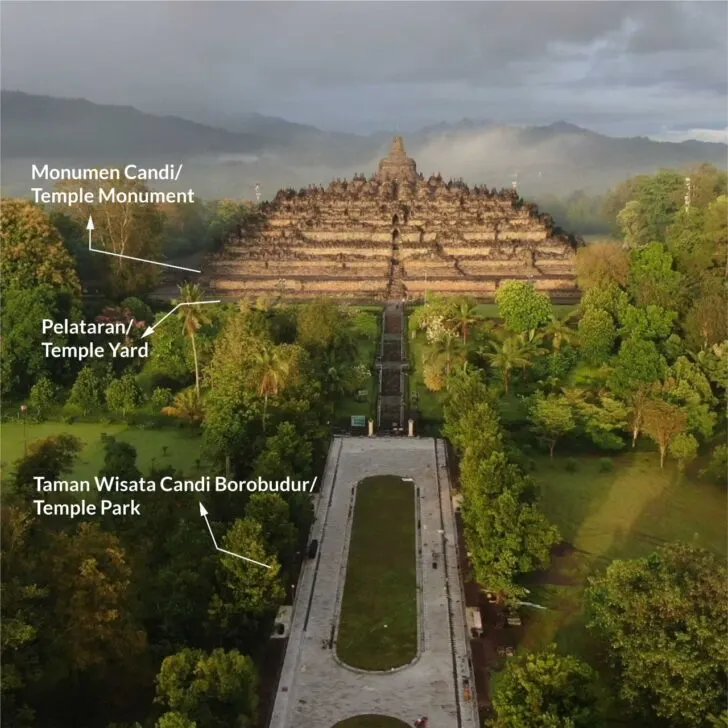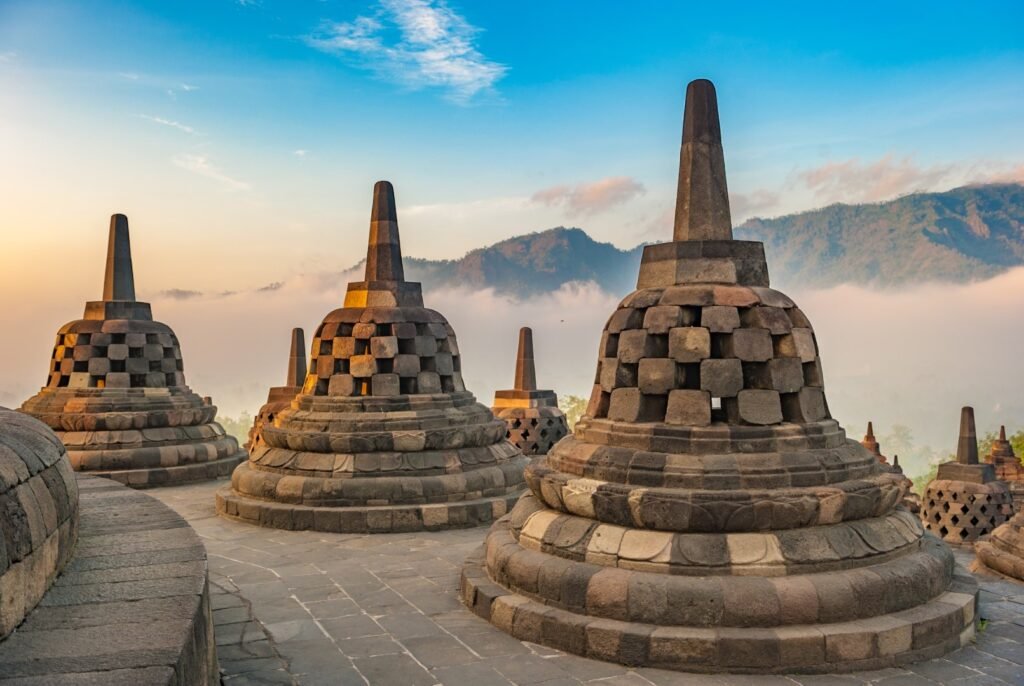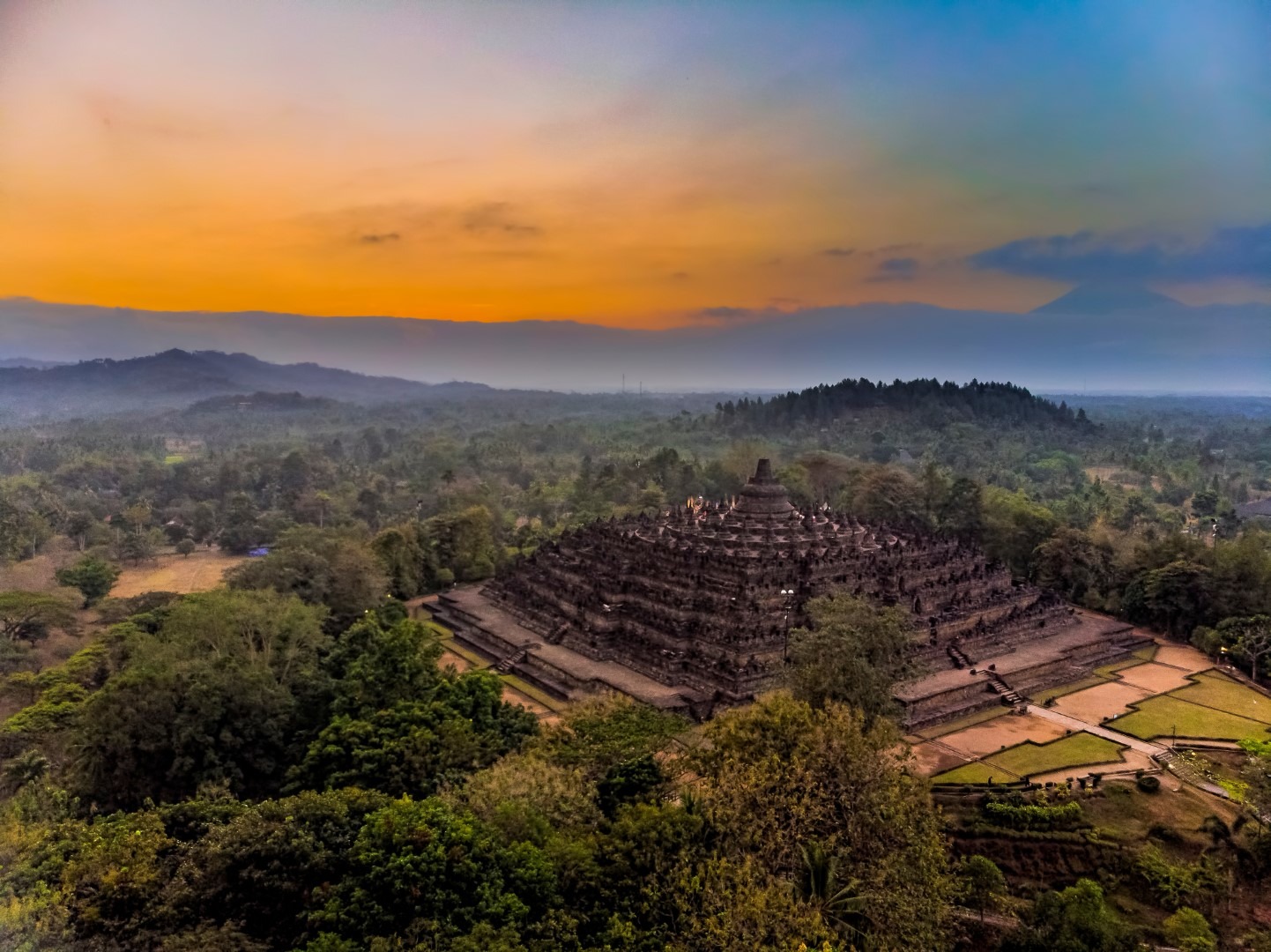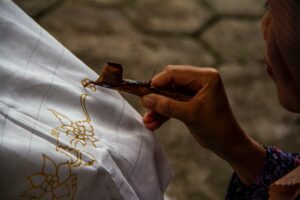The Borobudur Temple, a monumental structure constructed between the 8th and 9th centuries, is Indonesia’s most significant Buddhist temple compound. Situated in the Central Java province, it is commonly accessed from the vibrant city of Yogyakarta rather than Semarang.
Known as Candi Borobudur in the Indonesian language, this awe-inspiring temple reflects the historical significance of ancient stone temples constructed during Indonesia’s Hindu and Buddhist eras. The Borobudur Temple Compound encompasses Borobudur, Mendut, and Pawon, all collectively recognized as UNESCO World Heritage Site in 1991, coinciding with the recognition of Prambanan.
Within this guide, We will provide essential travel information to ensure a rewarding visit to this remarkable site.
Borobudur Temple Operating Hours
Borobudur is open daily except during special occasions (such as Vesak Day).
| Admission to opening | g Hours |
|---|---|
| Ticket counter | 6.30am to 4.30pm daily temple |
| e Park / Taman Wisata Candi Borobudur | 7am to 5 pm daily temple |
| e Yard / Pelataran | 7am to 5 pm daily temple |
| e Monument / Monumen Candi | 8.30am to 5 pm Tue-Sun (limited quota per day) |
Suppose you plan to witness the breathtaking sunrise at Borobudur at approximately 4:30 am. In that case, I would like you to obtain a special ticket giving you early morning access before the official opening hours. Later in this article, I will provide further details on acquiring this ticket, or you or visit this page >> Borobudur Sunrise Tour Package.
Ascending to the pinnacle of the temple is indeed possible. However, to do so, you must join a queue and secure a designated timeslot. Each day, eight hourly timeslots are available, commencing from 8:30 am and concluding with the final slot at 3:30 pm. It is highly advisable to arrive early at the temple to make sure you have a chance to climb.
Just to let you know, climbing Borobudur allows for a captivating and immersive experience, so I encourage you to seize the chance to explore its heights.

Borobudur Temple Entrance Fee
Below are the official ticket prices for entering Borobudur Temple during the regular visiting hours, excluding the special sunrise hours:
| For | Official Ticket Price |
|---|---|
| Adult (Foreigner) – Ground Only | IDR 375,000 |
| Child (Foreigner) – Ground Only | IDR 225,000 |
| Adult (Foreigner) – Ground & Temple | IDR 455,000 |
| Child (Foreigner) – Ground & Temple | IDR 305,000 |
| Adult (Local) – Ground Only | IDR 50,000 |
| Child (Local) – Ground Only | IDR 25,000 |
| Adult (Local) – Ground & Temple | IDR 120,000 |
| Child (Local) – Ground & Temple | IDR 75,000 |
Child refers to children aged between 3 and 10 years old.
To purchase tickets for Borobudur Temple during regular visiting hours, you have two options:
- On-site Ticket Purchase: You can buy tickets directly at the ticket counter on-site.
- Online Ticket Purchase: Tickets can be purchased online from the official Candi Borobudur ticket website. On this website, you can directly purchase the ticket that allows you to climb the temple structure.
You can obtain a bundle ticket from the ticket counter if you want to visit Borobudur with Prambanan or Ratu Boko. The bundle ticket costs USD 45 (Adults) and USD 27 (Children) for foreigners. (Source)
Please remember that Samudera Raksa Museum requires a separate ticket.
It’s important to check the official sources or ticket counters for the most accurate and up-to-date information on ticket prices and availability.
How to Visit Borobudur Temple For Sunrise

To visit Borobudur Temple for sunrise, here is a step-by-step guide and some considerations to keep in mind:
Advantages of Sunrise Visit:
- Less crowded environment to explore the temple
- Stunning views of the temple and its surroundings during the golden hour
- Possibility of clear views of Mount Merapi due to clearer morning skies
Considerations:
- Early Wake-up Time: Be prepared to wake up very early, around 3 am or 3:30 am, depending on your location.
- Higher Entrance Fee: Remember that the entrance fee for the sunrise visit is usually more expensive than regular visiting hours.
- Pre-arranged Transportation: Arrange transportation in advance to reach the temple for the sunrise experience.
Two Options for Sunrise Visit:
- From Manohara Hotel:
- Head to Manohara Hotel, located next to Borobudur, and aim to arrive before 4:30 am.
- Purchase a special ticket on-site (or book in advance by emailing them) at the hotel.
- With the special ticket, you can enter Borobudur Temple from Manohara and enjoy the sunrise. On their website, you can find more details about the Borobudur Manohara Package (BMP).
- From Punthuk Setumbu Hill:
- Punthuk Setumbu Hill is not within Borobudur itself but is a popular viewpoint to watch the sunrise over Borobudur Temple.
- One option is to take a private tour that includes transportation. The tour will pick you up from your hotel at around 3:30 am and drive you to Punthuk Setumbu Hill to witness the sunrise. Afterward, the tour will take you to Borobudur Temple and Prambanan Temple within the day.
Plan your itinerary accordingly and consider the time needed for transportation and exploration. Enjoy your sunrise visit to Borobudur Temple!

How to Get to Borobudur Temple
To reach Borobudur Temple, there are several transportation options available:
- Taxi/Ride-hailing >> Contact Us
- Borobudur Temple is approximately 40km from Malioboro, the central area of Yogyakarta.
- Taking a taxi or ride-hailing service is a convenient option. The journey usually takes 1.5 to 2 hours, depending on traffic conditions.
- The fare typically ranges from IDR 300k to 350k per way.
- Private Car Charter >> Contact Us
- Renting a private car with a driver is recommended if you plan to visit multiple places in a day or have a custom itinerary.
- With a private car charter, you can explore Borobudur and nearby attractions such as Candi Mendut and Merapi Mountain and purchase souvenirs like bakpia.
- During the 10-hour rental period, you can choose your destinations and dining options.
- Private Tour >> Check our Borobudur Sunrise Tour Package
- If you want to visit both Borobudur and Prambanan in a day, a private tour is a suitable option.
- The tour package typically includes a private car charter, a local driver, entrance tickets, and an optional tour guide.
- Bus (Trans Jogja):
- Trans Jogja Bus 2A and 2B connect downtown Yogyakarta to Jombor Terminal.
- From Jombor Terminal, you can take a local bus to Borobudur Terminal.
- At Borobudur Terminal, you can walk or take a horse carriage to reach Borobudur Temple.
- Please check the entire route of Trans Jogja for further details.
- Bus (DAMRI):
- If you are arriving at Yogyakarta International Airport (YIA), you can take the DAMRI bus directly from the airport to Borobudur.
- As the route and timetable may change, it is recommended to approach the DAMRI counter at the airport for the latest information on routes, timetables, and fares.
Consider the time, convenience, and flexibility when choosing the transportation method that best suits your needs.
Borobudur Temple History
Borobudur Temple holds a rich history that spans several centuries. Here are the key points about the temple’s history:
- Construction: Borobudur Temple was built during the 8th and 9th centuries (between AD 780 and 840) under the patronage of the Syailendra Dynasty, which ruled Java for approximately five centuries until the 10th century.
- Purpose: The temple was constructed as a place of worship dedicated to Buddha and a significant pilgrimage site for seekers of enlightenment and wisdom based on Buddha’s teachings.
- Abandonment: Following the decline of the Syailendra Dynasty, Borobudur was gradually abandoned between the 10th and 15th centuries. The power shifted to East Java, and the influence of Islam grew on the island.
- Rediscovery: Borobudur Temple remained concealed and largely forgotten until it was rediscovered by Sir Thomas Stamford Raffles in 1814. His findings sparked global interest and initiated efforts to protect and restore the temple.
- Restoration: In the 1970s, a collaborative endeavor between the Indonesian Government and UNESCO was undertaken to restore Borobudur to its former grandeur. The restoration aimed to preserve the temple’s intricate stone carvings and architectural integrity.
- Architectural Structure: The main building of Borobudur Temple comprises three primary spheres representing the stages of attaining enlightenment:
- Kamadhatu: The lowest level, symbolizing the sphere of desires. It features 160 carvings depicting human behaviors influenced by selfishness and the law of cause and effect (karma).
- Rupadhatu: The middle section represents the sphere of forms. It contains stone carvings and niches housing statues of Buddha, illustrating various aspects of Buddhist teachings.
- Arupadhatu: The highest section, located at the top of the temple, signifies the sphere of formlessness. It consists of three circular terraces leading to a central stupa. Each deck is adorned with perforated stupas, encompassing 72 stupas with Buddha statues inside.
Borobudur Temple is an awe-inspiring testament to ancient Buddhist architecture and remains an important cultural and historical landmark in Indonesia.





